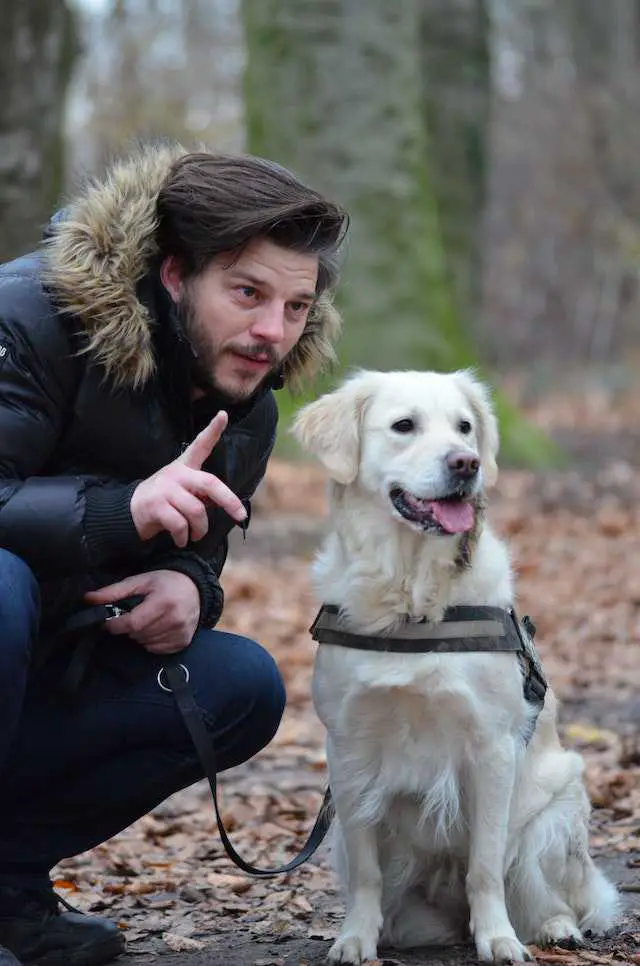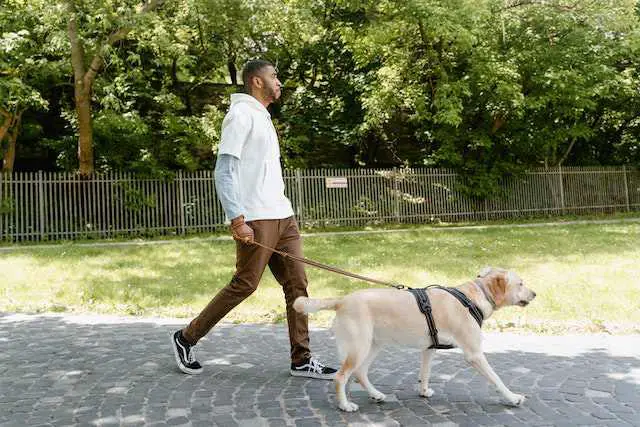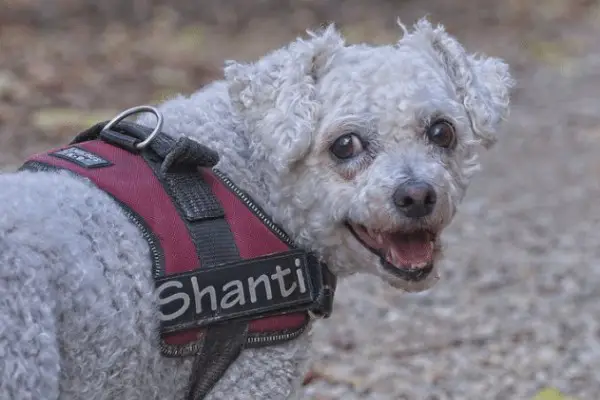14 Most Common Dog Training Mistakes To Avoid

Hey there, fellow dog parents! Are you struggling with dog training? Don’t worry, we’ve all been there!
From inconsistent commands to not rewarding positive behavior, we’ve got you covered.
In this blog post, we’re going to dive into the most common dog training mistakes and share some expert tips to help you and your furry friend succeed.
Let’s get started!
Dog Training Mistakes
Dog training mistakes can hinder the progress of training and create behavioral issues. One common mistake is inconsistent or unclear commands, which can confuse the dog.
Another mistake is using punishment-based methods instead of positive reinforcement, which can lead to fear and aggression.
It is important to establish clear communication and use positive reinforcement techniques to effectively train dogs.
Let’s dive deeper…
The following are some of the most common dog training mistakes to avoid and how to address them:
1. Inconsistent Commands

Inconsistent commands during dog training can hinder progress and confuse the dog. It is essential to be precise and consistent with the commands you give your dog.
To address this mistake, start by establishing clear and consistent verbal cues for each command. Use the same words and tone of voice every time. Reinforce the commands with consistent hand signals or gestures.
Practice the commands in different environments and gradually increase distractions to ensure consistency. Lastly, reward your dog for following commands consistently to reinforce the desired behavior.
2. Not Rewarding Positive Behaviors
Not rewarding positive behaviors during dog training is a common mistake that can hinder progress. By failing to provide rewards, dogs may not understand which behaviors are desired.
To address this, it is crucial to use positive reinforcement consistently. Rewarding good behavior with treats, praise, or playtime reinforces the desired actions.
Additionally, using a marker, such as a clicker, can help signal to the dog that they have performed correctly and will receive a reward. Consistency, clear communication, and timely rewards are key to effectively addressing this training mistake.
3. Skipping Basic Training
Skipping basic training can be a detrimental mistake in dog training. Basic training provides the foundation for good behavior and obedience. To address this mistake, it is crucial to start with basic commands like sit, stay, and come.
Consistency is key, so regular training sessions should be scheduled. Positive reinforcement, such as treats and praise, should be used to reward desired behavior.
Patience and persistence are necessary to ensure that the dog understands and follows the commands consistently.
Read more about exercising your dog.
4. Punishing Instead of Redirecting
Punishing instead of redirecting is a common dog training mistake that can have negative consequences. Instead of using punishment, it is important to redirect the dog’s behavior towards more appropriate actions.
To address this mistake, it is crucial to focus on positive reinforcement and reward-based training methods. Use treats, praise, and toys to reinforce desired behaviors and redirect the dog’s attention away from unwanted behaviors.
Consistency and clear communication are key in dog training, so be sure to set clear boundaries and provide consistent cues to guide your dog’s behavior.
Above all, patience and understanding are fundamental in creating a positive and effective training environment for your dog.
5. Not Understanding Breed Differences
Not understanding breed differences is a common dog training mistake that can hinder progress. Each breed has unique characteristics and instincts that should be taken into account during training.
To address this, it is crucial to research and understand the specific breed you are working with. Tailor your training methods and techniques to accommodate the breed’s needs and natural tendencies.
Additionally, seek guidance from experienced trainers or breed-specific resources to gain insights and strategies for effective training. By acknowledging and respecting breed differences, you can optimize your training sessions and achieve better results.
6. Giving Up Too Soon
Giving up too soon is a common dog training mistake that can hinder progress. To address this, consistency is key. Maintain a regular training schedule and stick to it, even when progress seems slow.
Break down commands into smaller, manageable steps and reward the dog for each successful attempt. Additionally, use positive reinforcement techniques to encourage desired behaviors, such as treats or praise.
Finally, seek professional help or attend training classes if needed, as an experienced trainer can provide guidance and support.
7. Waiting Too Long to Start Training
Waiting too long to start training is a common dog training mistake. It is important to address this issue early on to avoid behavioral problems. To address it, start training your dog as soon as you bring them home.
Use positive reinforcement techniques, such as treats and praise, to reward desired behaviors. Break down training into short and consistent sessions to keep your dog engaged.
Seek professional help if needed, such as enrolling in obedience classes or consulting a professional dog trainer. By addressing this mistake early, you can set a solid foundation for your dog’s training and behavior.
8. Not Training Enough

Not training enough is a common mistake in dog training that can hinder progress and limit the effectiveness of training sessions. To address this, it is essential to establish a consistent training schedule and allocate dedicated time for training sessions each day.
Short, frequent training sessions are more effective than long, sporadic ones. Additionally, incorporating training into daily routines, such as during walks or playtime, can help reinforce learned behaviors.
It is important to prioritize quality over quantity during training sessions, focusing on clear communication, positive reinforcement, and gradual progression. Regular practice and repetition are key to maintaining and reinforcing desired behaviors over time.
9. Impatience
Impatience is a common dog training mistake that can hinder progress. To address impatience during training sessions, it’s important to first recognize and manage your own emotions.
Take deep breaths and remain calm and composed. Break down training tasks into smaller, achievable steps and celebrate each small success. Provide clear and consistent instructions to your dog, using positive reinforcement techniques.
Remember that training takes time and patience, so be prepared to invest the necessary effort and give your dog ample opportunities to learn and grow.
10. Harsh Discipline
Harsh discipline is considered a dog training mistake because it can lead to fear, anxiety, and aggression in dogs. Instead of relying on punishment, positive reinforcement techniques should be used to encourage desired behaviors.
During training sessions, it is crucial to maintain a calm and patient demeanor, avoiding any physical or verbal aggression towards the dog.
Establishing clear and consistent rules, along with using rewards such as treats and praise, will create a positive learning environment and foster a strong bond between the dog and the trainer.
Consistency and repetition are key in addressing harsh discipline and promoting effective and humane dog training.
11. Incorrect Timing With Rewards/Praise
Incorrect timing with rewards/praise is a common dog training mistake that can hinder progress. Timing is crucial because dogs need immediate feedback to understand the desired behavior.
If rewards or praise are given too late or delayed, the dog may associate it with a different action, leading to confusion. To address this, trainers should provide rewards or praise immediately after the dog performs the desired behavior.
This ensures that the dog can make the connection between the action and the positive reinforcement, strengthening their understanding and motivation to repeat the behavior.
Consistent and precise timing will enhance the effectiveness of dog training sessions and accelerate progress.
12. Reinforcing Bad Behavior
Reinforcing bad behavior is a common dog training mistake that can hinder progress. To address this, it is important to identify the specific behaviors that need to be corrected. Consistency is key in training, so avoid unintentionally rewarding undesirable actions.
Instead, focus on positive reinforcement by rewarding good behavior promptly and consistently. Redirecting the dog’s attention to appropriate behaviors and providing clear cues can also help in addressing and correcting bad behavior during training sessions.
Finally, seeking professional guidance from a qualified dog trainer can offer valuable insights and techniques to effectively address and correct bad behavior.
13. Only Training in One Place

Training a dog in only one location can be a mistake because it limits the dog’s ability to generalize commands and behaviors across different environments. To address this, it is important to introduce training sessions in various locations to expose the dog to different stimuli and distractions.
Start by practicing basic commands in a quiet and familiar environment, gradually increasing the difficulty by moving to different areas with more distractions. This will help the dog learn to respond to commands regardless of the location, enhancing their overall obedience and reliability.
Additionally, incorporating real-life scenarios, such as training during walks or outings, can further reinforce the dog’s training and ensure their responsiveness in different settings.
14. Using Fear-Based Methods
Using fear-based methods as a dog training technique is a mistake that can have negative consequences. Instead, positive reinforcement should be the focus of training sessions.
To address this mistake, trainers should avoid using techniques that cause fear or discomfort to the dog, such as physical punishment or yelling.
Instead, they should use rewards, such as treats or praise, to reinforce desired behaviors. Consistency, patience, and understanding the individual needs of each dog are key to successful training without fear.
Frequently Asked Questions
What are some common mistakes dog owners make when training their pets?
One common mistake is inconsistency. Dogs thrive on routine, so if you’re not consistent with your training methods, it can confuse them. Another mistake is using punishment-based methods instead of positive reinforcement, which can lead to fear and anxiety in your furry friend.
How can I avoid making these mistakes?
To avoid inconsistency, establish a consistent training schedule and stick to it. Use positive reinforcement techniques, such as treats and praise, to reward good behavior. It’s also crucial to educate yourself about different training methods and seek professional help if needed.
Are there any specific training techniques that should be avoided?
Yes, there are a few techniques that should be avoided. Physical punishment, like hitting or yelling at your dog, can damage the bond between you and cause fear and aggression. Avoid using outdated dominance-based training methods that focus on being the “alpha” and instead focus on building a positive relationship with your dog.
What should I do if my dog is not responding to the training?
If your dog is not responding to your training efforts, it’s important to assess whether you’re using the right techniques for their personality and needs. Sometimes, seeking the assistance of a professional dog trainer can be beneficial in identifying any specific issues and tailoring the training approach accordingly.
Can I train my dog on my own, or should I seek professional help?
While many dog owners successfully train their dogs on their own, seeking professional help can be invaluable, especially if you’re facing challenges or aren’t sure where to start. A professional trainer can guide you with personalized advice, provide structure, and help you avoid common mistakes.
Is it ever too late to correct training mistakes?
It’s never too late to correct training mistakes. Dogs are highly adaptable, and with patience, consistency, and positive reinforcement, you can reshape their behavior. Whether your dog is a puppy or an adult, investing time and effort in training can lead to a happier and well-behaved companion.
Read more about the signs of a poorly socialized dog.
Conclusion
In conclusion, dog training mistakes can happen to anyone, but with a little awareness and effort, they can be avoided.
Remember to be patient with your furry friend, communicate clearly, and always use positive reinforcement.
Together, we can create a happy and well-trained doggy companion.






